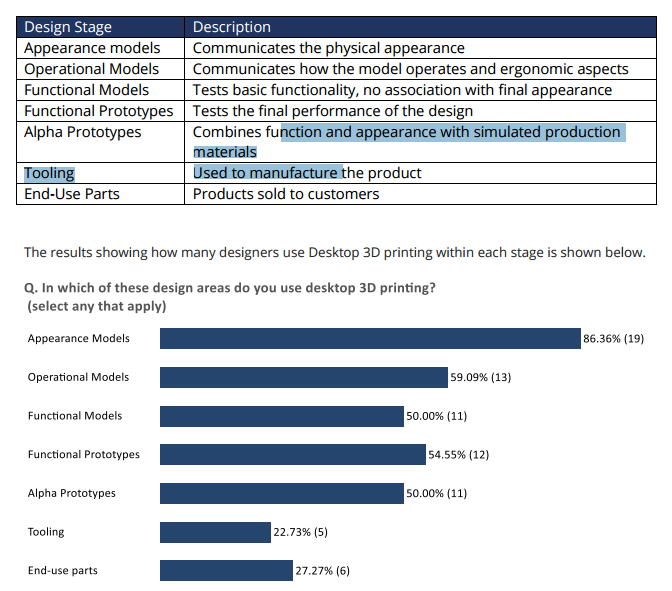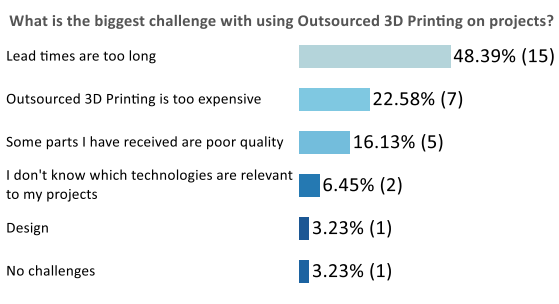From the Desktop to the Service Bureau: Made for Me Releases Results of Industrial Designer’s Survey
 If you have access to a 3D printer, whether at home, the office, or at your university—where perhaps there is even an entire room of shiny machines in front of you—chances are you are dying to use the technology whenever possible. And while there are many things that are faster to procure from a quick and inexpensive jaunt to Amazon or a short drive to the hardware or discount store, it’s certainly a lot more fun to watch a model being made layer by layer, as if summoned by magic.
If you have access to a 3D printer, whether at home, the office, or at your university—where perhaps there is even an entire room of shiny machines in front of you—chances are you are dying to use the technology whenever possible. And while there are many things that are faster to procure from a quick and inexpensive jaunt to Amazon or a short drive to the hardware or discount store, it’s certainly a lot more fun to watch a model being made layer by layer, as if summoned by magic.
The topic of when 3D printing is actually necessary and when it’s not comes up more often now, especially among artists and designers—many of whom still enjoy CNC machining, casting, and crafting pieces by hand, as well as using newer technology. More importantly, when you are just learning how to use the technology, sometimes it’s hit or miss as you learn when is the best time to focus on using 3D printing just for prototyping—or to shoot for functionality. With so many processes still in a fledgling state, there are no rules. And it’s always interesting to see what others are putting the hardware, software, and materials to use for—and when.
Made for Me, a company responsible for some very informative guides (we’ve reported previously on their helpful information such as how to orient parts in ABS printing as well as tips for SLS 3D printing with nylon) is now giving us some insight into why industrial designers choose to 3D print at certain times.
Their Design and 3D Printing Survey Results are quite enlightening as we find out about a number of different facets regarding 3D printing activity. This too was all the recent subject of a talk by Made for Me CEO James Antifaev as he attended the Making Things Happen conference in Detroit this week. The main points that he began with were in explaining the following:
- 51% of designers now use 3D printing within at least 60% of their projects
- 2/3 of designers now utilize an in-house 3D printer
- 63% of designers outsource some or all of their 3D printing
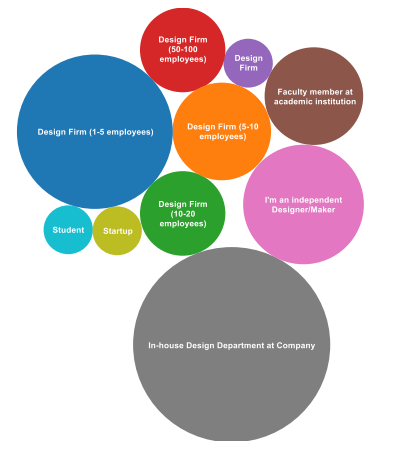 The full 25-page report goes into great detail, allowing us to see exactly when designers bring the technology into a project and why, as well as what equipment they are using and what challenges and obstacles they still experience. Made for Me also includes several case studies within the report that you can enjoy such as that of design firm Bright Product Development of Texas, Boa Technology of Colorado, and MistyWest of Vancouver, BC.
The full 25-page report goes into great detail, allowing us to see exactly when designers bring the technology into a project and why, as well as what equipment they are using and what challenges and obstacles they still experience. Made for Me also includes several case studies within the report that you can enjoy such as that of design firm Bright Product Development of Texas, Boa Technology of Colorado, and MistyWest of Vancouver, BC.
Pointing out that the Industrial Designers Society of America believes an industrial design process contains 32 possible steps—with 15 of them involving the building of models and prototypes—the Made for Me team wanted to find out exactly how they integrated 3D printing into these steps. With the benefits of 3D printing, obviously artists can find themselves able to work better, faster, and more affordably.
“Due to the pace of change, however, many designers are still learning about the potential for these new approaches,” states Made for Me.
The survey, listing 38 questions, is not affiliated with any 3D printer manufacturer. They received 47 complete responses, with two arriving only partially completed. The majority of responses came from the US and, after that, Canada. Those taking the survey were mainly in-house design departments for both large companies and smaller firms, with some having as few as one to five employees. Respondents had a fair amount of experience in that generally they were designers at the senior level or business owners who had been working in their field for at least ten years. As a cumulative group, the respondents had a wide range within industrial design, with many specializing in consumer products.
Both the curiosity and need to gather data regarding 3D printing among designers comes about as popularity in use of the technology surges from a community just beginning to learn about it to one that is beginning to offer valuable innovation and master the processes involved. Two-thirds of those taking the survey own printers, and the rest outsource their work.
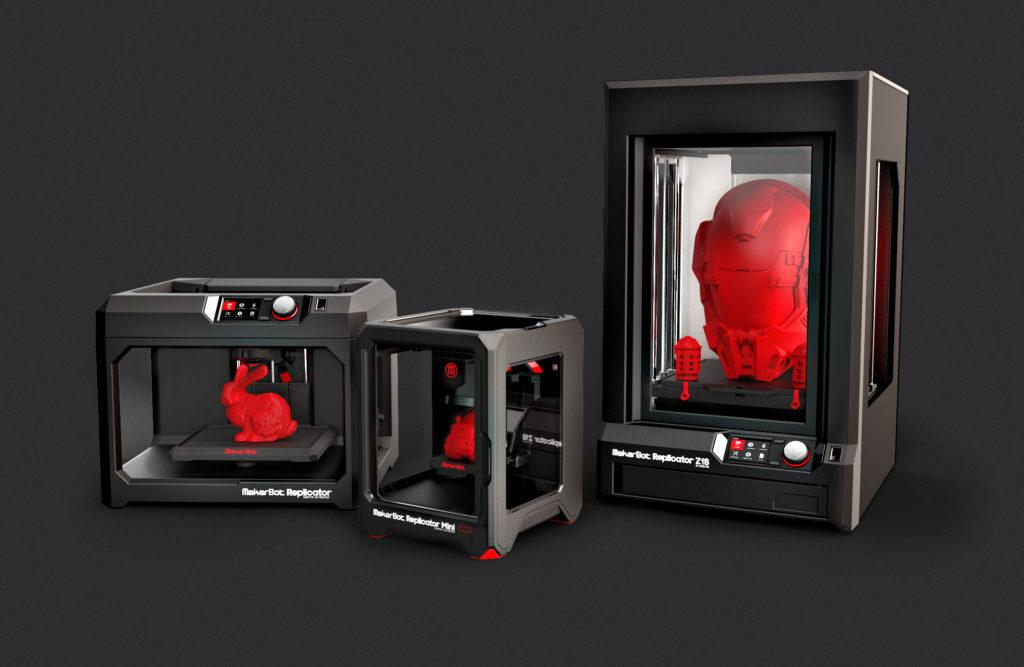
The MakerBot was the most popular 3D printer brand used, according to the survey regarding desktop 3D printing.
Examining in-house desktop 3D printing (consumer level machines retailing for between $1,000 and $5,000 USD), the survey found that 45% owned desktop 3D printers and gained information regarding purchasing through online sources. A large portion are using a MakerBot 3D printer (47.37%) with 3D Systems hardware coming in at 21.05%, and the next six making up 5.26% each, from the Up Plus 2 to the Dremel.
“Desktop 3D printing is a very crowded market and it can be difficult to determine which Desktop 3D printer provides the best fit for an organization’s requirements,” states Made for Me.
It was a bit surprising to see how few are actually using 3D printing for functionality as opposed to prototyping, with 86% stating that they see 3D printing technology coming into play for appearance, and 59% using 3D printing for operational models. Only 27% are using 3D printing at the desktop for end-use products.
“This fits with the trends highlighted elsewhere in the response data that desktop 3D printing is good for parts that need a quick turnaround where quality, aesthetics or functionality are not the primary concern,” states Made for Me.
In terms of benefits and as to why they would use 3D printing, the results were enlightening. Speed was listed by 50% as the key benefit of 3D printing, while nearly 23% see affordability as the greatest perk. Also surprisingly, 41% of the users said that in terms of what they found challenging, it was poor quality in parts. With the rising number of 3D printers in the marketplace today, quality has become much better, and the percentages here would suggest that perhaps some of the quality issues are also due to lack of knowledge by the users. 27% said that they considered the equipment difficult to use.
Considering it’s been projected for quite some time that 3D printing would cast traditional processes out, the question regarding what other technologies designers still consider using was one of great interest. CNC machining was of course at the top of the list by just over 86.36% with casting, traditional metal/woodworking, and handmade products emerging next as alternatives. Silicone molding (27.27%) and injection molding (13.64%) were at the bottom of the list. In combination with this question, 54.55% would indeed refer to traditional technology instead to achieve better part quality.
 Examining commercial 3D printing, it was certainly not a shock to hear that price is a major issue for a number of businesses. Defined as those that typically cost more than $20,000, this technology generally includes:
Examining commercial 3D printing, it was certainly not a shock to hear that price is a major issue for a number of businesses. Defined as those that typically cost more than $20,000, this technology generally includes:
- Selective Laser Sintering (SLS)
- Stereolithography (Polyjet, Visijet)
- Powder binding (ProJet)
- Fused Deposition Modelling (FDM)
- Direct Metal Laser Sintering (DMLS)
- Selective Laser Melting (SLM)
“Due to their cost, commercial machines represent a much larger investment for owners, yet 21 out of 49 respondents (43%) indicated their organization owns a commercial 3D printer,” stated Made for Me.
Most found out about printer purchases either at tradeshows and conferences or online, with a whopping 64% choosing Stratasys 3D printers. 3D Systems was of course the next obvious choice, with 21.43% responding that was what they had in their offices. Here, speed was again the greatest benefit discovered, according to two-thirds of respondents, and nearly 24% referred to better product quality as their motivation. Most did view purchasing a commercial 3D printer to be too expensive, however, at 47.62%.
“Designers had clear thoughts on the biggest drawback to commercial 3D printing, with cost of machines being identified as a significant challenge,” stated Made for Me. “This is understandable given that commercial printers start at $20,000 USD and can cost as much as $1M USD. The high cost of equipment may help to explain why outsourcing 3D printing remains a popular choice among designers, with 63% outsourcing some of their 3D printing.”
Views at the commercial level for alternatives in traditional technologies were very similar to those of the desktop level, with CNC machining at the top at 76%, with 38% seeking better parts. 28.57% of commercial users were shying away from 3D printing because they thought there was a lack of materials in regards to the projects they were working on.
“The number one reason that designers would use an alternative manufacturing method to 3D printing was the ability to get higher quality parts,” states Made for Me. “However, this answer was less common for commercial 3D printing than it was for desktop 3D printing; this is not surprising, since commercial 3D printing can provide higher levels of quality than desktop.”
“The second most common reason that designers opt for a non-3D printing manufacturing technique is that they don’t believe the material they need is available using 3D printing. This points to the fact that for some materials, 3D printing is still of limited use. However, a lack of knowledge of the availability of certain materials within 3D printing may also account for some of these responses.”
For commercial users, there was a big difference to be seen in what they are actually using 3D printing technology for. While nearly 86% are using 3D printing again strictly for appearances, 76.19% are actually expecting functionality.
When examining those who use 3D printing through outsourcing, Made for Me took into account that many outsourcing entities obviously have greater capability. They do require a turnaround time, and the self-sustainability in design and production is reduced for the user. The survey showed that 63% still use outsourcing for one reason or another, with word of mouth being the most common method of finding a good vendor, along with investigating online. A good number of commercial clients seem to be shopping for service bureaus through trial and error as well (48.39%). Nearly all outsourcing is performed domestically, according to the survey respondents, while 25.81% use a combination of international and domestic.
Outsourcing allows more access to different equipment and materials, and obviously, businesses aren’t beholden to make huge investments for onsite 3D printing. They seemed to find overall that the key benefit is in access to a variety of material and technology (41.94%) with the major challenge being that lead times are too long. Some did find that outsourcing is too expensive (22.58%), while a fairly low number listed poor quality (16.3%) as an issue.
In using outsourcing as a vehicle for 3D printing, results were more varied in their reasons. With 67.74% using outsourcing for appearance, we saw also that 61.29% were interested in 3D printing for functional models and 54.84% were looking for functional prototypes.
Future trends show that most designers see continued 3D design and 3D printing technology in their futures, with 51% seeing a potential increase in the use of 3D printing and 46.81% seeing it as staying the same. Even with some challenges, obstacles, and perhaps some complaints, a whopping majority plan to be using 3D printing as much or more this year. Made for Me pointed out that only one designer answering the survey indicated a desire to decrease the amount of 3D printing being used.
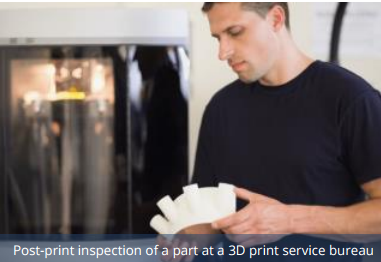 In asking opinions on how respondents saw a way for 3D printing to increase, it was by majority that most agree pricing needs to come down. This is indeed a big issue for many, but there are certainly many more affordable 3D printers than before, as patents have expired, leaving more room for competition in the marketplace in terms of equipment. Not only do users see that prices for 3D printers need to come down, but they also think that service bureaus need to charge less, and there needs to be more choice in materials. Education was a major concern, while greater transparency, and better software tools were at the bottom of the list, but still obviously of great importance too.
In asking opinions on how respondents saw a way for 3D printing to increase, it was by majority that most agree pricing needs to come down. This is indeed a big issue for many, but there are certainly many more affordable 3D printers than before, as patents have expired, leaving more room for competition in the marketplace in terms of equipment. Not only do users see that prices for 3D printers need to come down, but they also think that service bureaus need to charge less, and there needs to be more choice in materials. Education was a major concern, while greater transparency, and better software tools were at the bottom of the list, but still obviously of great importance too.
While there are a few minor surprises in the results of the survey—and of course everyone takes away something different from their own experiences and perceptions—it would seem that the survey indicates what most companies and analysts project, with growth in the future as affordability and accessibility continue, and as makers and businesses continue to learn to take advantage of the technology with a variety of different methods. Discuss further in the 3D Printing Survey Results over at 3DPB.com.
[Source: Made for Me]Subscribe to Our Email Newsletter
Stay up-to-date on all the latest news from the 3D printing industry and receive information and offers from third party vendors.
You May Also Like
Precision at the Microscale: UK Researchers Advance Medical Devices with BMF’s 3D Printing Tech
University of Nottingham researchers are using Boston Micro Fabrication‘s (BMF) 3D printing technology to develop medical devices that improve compatibility with human tissue. Funded by a UK grant, this project...
GaeaStar and Verve Coffee Roasters Start Pilot Production of Sustainable 3D Printed Coffee Cups
Following a 2022 debut in Germany, GaeaStar, a startup based in San Francisco and Berlin, has begun US pilot production of its sustainable, disposable clay cups and bowls made with...
Meltio and Accufacture Unveil Robotic Metal 3D Printer Made in the US
Meltio has partnered with Michigan-based robotics firm Accufacture to introduce Alchemist 1, a robotic cell designed for wire-laser metal 3D printing made in the US. This new system represents a...
WASP Highlights Advances in Healthcare 3D Printing at Italy’s Exposanità 2024
WASP takes center stage at Italy’s leading healthcare expo, Exposanità 2024, demonstrating the transformative impact of its advanced 3D printing technologies on the medical sector. Known for its line of...


